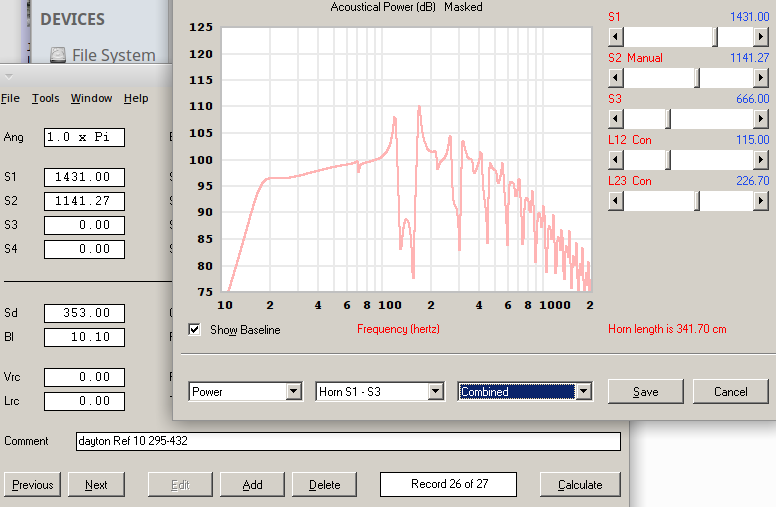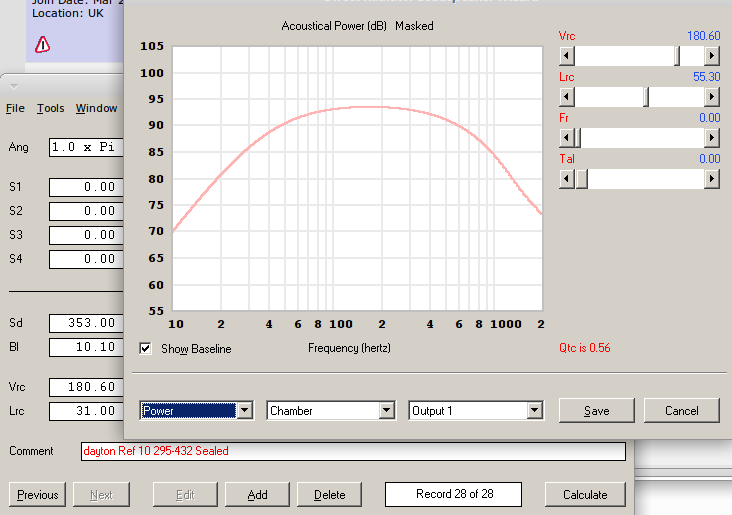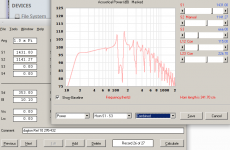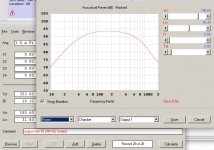When using multiple woofers (2 or 4) in the same transmission line could one use a "point five" type crossover where half of the woofers cover the entire woofer spectrum and the other half are brought in only for the lowest frequencies to compensate for natural rolloff, higher xmax requirements, and baffle step? would the line behaviour be messed up by having different number of drivers active over the range of use? I am thinking that since all drivers would be active in the lower two or three octaves where the line is really effective that it should work but thought I would ask the experts.
mike
mike
I can't address your main question, but trying to use 4 drivers in a common line is not likely to work very well since the line's design will be based on a design center that would coincide with the midpoint of the 4-driver array. The top and bottom drivers in the array will be rather far from the design center and the line probably won't function as you'd hope because the concept of multiple drivers sharing a line is based on them acting as a single, larger driver. A pair of drivers, however, are close enough to function quite well as a single driver.
Paul
Paul
When using multiple woofers (2 or 4) in the same transmission line could one use a "point five" type crossover where half of the woofers cover the entire woofer spectrum and the other half are brought in only for the lowest frequencies to compensate for natural rolloff, higher xmax requirements, and baffle step? would the line behaviour be messed up by having different number of drivers active over the range of use? I am thinking that since all drivers would be active in the lower two or three octaves where the line is really effective that it should work but thought I would ask the experts.
mike
pkitt, that is not a bug, it is a feature. At wavelength of featured pipe fundamental, all drivers are still neibor enuff to act as one, while at buggin harmonics they fuzz it out.
There is a loudspeaker, made of someone, who does not care much for the truth and human decency, but which works with two bass-reflex drivers, which use a baffle step EQ half cross-over and play within the same enclosure.
There is a loudspeaker, made of someone, who does not care much for the truth and human decency, but which works with two bass-reflex drivers, which use a baffle step EQ half cross-over and play within the same enclosure.
Regarding low-passing one of a pair of drive units (presumably at a lower frequency than the other for a multiway), then assuming the line is properly designed for the pair of drivers, yes, there's no reason why not. We're fundamentally talking about variations on back-loading here, so if you can do it with a reflex you can do it with a TL, horn or whatever, assuming it's equally well implemented.
Re 4 drive units -depends. Assuming close positioning a pair of drivers will essentially function as one, with the centre of excitation at the mean distance from the throat (sealed end). And there's no fundamental issue with exciting a line at more widely separated locations -that's how Tom Danley's [double] tapped horns and earlier designs like the Jensen Transflex work. Four units in a line? Potentially a bit of both, but assuming a small physical driver array length / line length ratio, it should be rather closer to the former. It's been done (more or less) in several existant designs -Newtronics run a variation on that theme for example, albeit with 3 units in the line.
Re 4 drive units -depends. Assuming close positioning a pair of drivers will essentially function as one, with the centre of excitation at the mean distance from the throat (sealed end). And there's no fundamental issue with exciting a line at more widely separated locations -that's how Tom Danley's [double] tapped horns and earlier designs like the Jensen Transflex work. Four units in a line? Potentially a bit of both, but assuming a small physical driver array length / line length ratio, it should be rather closer to the former. It's been done (more or less) in several existant designs -Newtronics run a variation on that theme for example, albeit with 3 units in the line.
Last edited:
Four drivers may work out okay but it will be dependent, as you pointed out, on how large the drivers are relative to the line length and I wouldn't assume success without knowing more about the specifics.
Paul
Paul
Regarding low-passing one of a pair of drive units (presumably at a lower frequency than the other for a multiway), then assuming the line is properly designed for the pair of drivers, yes, there's no reason why not. We're fundamentally talking about variations on back-loading here, so if you can do it with a reflex you can do it with a TL, horn or whatever, assuming it's equally well implemented.
Re 4 drive units -depends. Assuming close positioning a pair of drivers will essentially function as one, with the centre of excitation at the mean distance from the throat (sealed end). And there's no fundamental issue with exciting a line at more widely separated locations -that's how Tom Danley's [double] tapped horns and earlier designs like the Jensen Transflex work. Four units in a line? Potentially a bit of both, but assuming a small physical driver array length / line length ratio, it should be rather closer to the former. It's been done (more or less) in several existant designs -Newtronics run a variation on that theme for example, albeit with 3 units in the line.
Have you already chosen the likely drivers to know that a tuning frequency of 15-30 Hz is going to be optimum? If so, how did you determine that frequency range will be optimum for those drivers?
Paul
Paul
I am thinking 8" or 10" drivers in a line tuned to 15-30Hz.
mike
Hmm, tuning a TL below driver Fs, might as well just seal it up with minimal damping unless high Qts and even then, better overall to tune it to Fs/Qts, so curious what the app/performance goal are.
Also, typical BSC corner frequency tends to be > 250 Hz, so I don't see this working out too well unless the drivers are in a square 4 layout or dual drivers and one bigger woofer to cut down the CTC spacing.
GM
Also, typical BSC corner frequency tends to be > 250 Hz, so I don't see this working out too well unless the drivers are in a square 4 layout or dual drivers and one bigger woofer to cut down the CTC spacing.
GM
+1. Unless those drivers have a fiendishly low Fs (by current standards, and not exactly common in heritage units either), I'm scratching my head a bit about the design goals. I know a couple of manufacturers use low-tuned lines sans damping as an alternative to sealed (!) but I fear that reflects more on their marketing rather than engineering departments. 
I have played with modelling a few drivers. My first interest in tuning below Fs was the bass shelf tuning of normal ported enclosures where tuning between 1/2 and one octave below Fs gives a bass shelf of 3 to 5 dB (some of which is made up by room gain). It gives two main advantages that I see; protection of the woofer from unloading and avoiding the boominess that one can get from overly flat low end boosted by room gain.
I noticed a similar response in TLs tuned similarly in simulations. The target low frequency range is based on the lowest musical note likely to be encountered is 16Hz (Low C 32' pipe) thus a preferred tuning to 16Hz. If necessary a compromise of one octave less extension sets the upper limit.

Sealed enclosures don't seem to provide anything like this level of extension or efficiency. The goal is a 2 or 2.5 way system with efficiency near 100dB/w/m. The 8 or 10 inch specification is to hopefully eliminate the need for a separate midrange driver.

Of course I suppose one could use two different size drivers (say 12 or 15 inch for the ".5" range). My initial thought was using identical drivers so that only one set of TS parameters would be applicable to the line design. If one does an actual three way that wouldn't be an issue as the upper bass drivers would not be really operating in the line's effective operating band but as a 2.5 they would.
Of course straight 2 is a possibility if using identical drivers also.
I noticed a similar response in TLs tuned similarly in simulations. The target low frequency range is based on the lowest musical note likely to be encountered is 16Hz (Low C 32' pipe) thus a preferred tuning to 16Hz. If necessary a compromise of one octave less extension sets the upper limit.
Sealed enclosures don't seem to provide anything like this level of extension or efficiency. The goal is a 2 or 2.5 way system with efficiency near 100dB/w/m. The 8 or 10 inch specification is to hopefully eliminate the need for a separate midrange driver.
Of course I suppose one could use two different size drivers (say 12 or 15 inch for the ".5" range). My initial thought was using identical drivers so that only one set of TS parameters would be applicable to the line design. If one does an actual three way that wouldn't be an issue as the upper bass drivers would not be really operating in the line's effective operating band but as a 2.5 they would.
Of course straight 2 is a possibility if using identical drivers also.
Attachments
Agreed, a big fan/user of EBS alignments, especially for Altec/similar [mid]bass horn drivers, so before T/S max flat [ML]TLs became popular I promoted them regularly, but a TL is basically a two octave device, so to acoustically protect them you either have to limit them to two octaves or damp them into submission, leaving virtually no extra acoustic gain BW over near IB sealed.
You want the best of both that will 'knock the socks off' an EBS, build a vented BIB [ML-horn]. I did a few corner loaded with 12" Jensen guitar amp drivers way back when for others and had enough [mid]bass to rival my huge dual 20 Hz Fs 15" 'subs'. Made me a believer in pipe horns.
GM
You want the best of both that will 'knock the socks off' an EBS, build a vented BIB [ML-horn]. I did a few corner loaded with 12" Jensen guitar amp drivers way back when for others and had enough [mid]bass to rival my huge dual 20 Hz Fs 15" 'subs'. Made me a believer in pipe horns.
GM
It's what I've done/recommended, though as a tower [aka MLTL nowadays] alignment, so a good compromise between size/performance compared to the ML-horn.
For high Qt [> ~1.0], I use[d] a proprietary TL alignment, though the more recent Fs/Qts sims near identical response in a smaller net Vb, so of course a little less efficient.
GM
For high Qt [> ~1.0], I use[d] a proprietary TL alignment, though the more recent Fs/Qts sims near identical response in a smaller net Vb, so of course a little less efficient.
GM
This is often considered for dealing with the baffle size, but there isn't really much to justify it. Unless there is a reason for it I would be hard pressed to let it complicate a design.2.5 way
- Status
- This old topic is closed. If you want to reopen this topic, contact a moderator using the "Report Post" button.
- Home
- Loudspeakers
- Multi-Way
- Multiple driver transmission line "1.5" crossover

